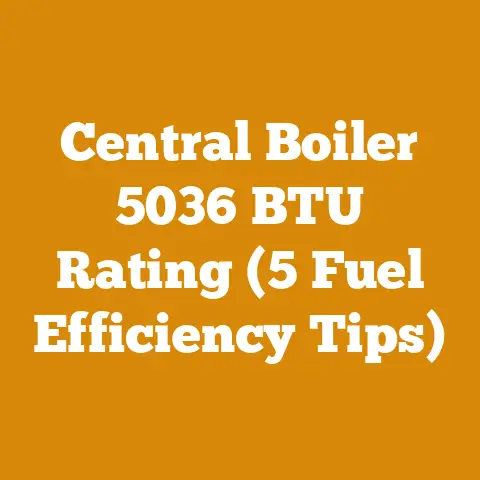Cost of Chainsaws Rust: Effective Chain Rust Removal Tips (Pro Guide)
Rust’s Silent Toll: A Pro Guide to Chainsaw Chain Maintenance
I’ve spent years in the woods, and let me tell you, rust is a constant adversary. It’s not just an aesthetic issue; it’s a silent killer of your chainsaw’s performance and a drain on your wallet. I remember one particularly harsh winter where I neglected my chainsaws, and the following spring, the chains were so heavily rusted they were practically unusable. Replacing them cost me a significant chunk of change and set my firewood production back weeks. That experience taught me a valuable lesson: proactive rust prevention is far cheaper than reactive rust removal or replacement. This guide is built on that lesson, offering practical advice and insights to keep your chainsaw chains in top condition.
The Importance of Tracking Project Metrics in Wood Processing and Firewood Preparation
Before we dive into the nitty-gritty of rust removal, let’s talk about why tracking project metrics is crucial in the wood processing and firewood preparation world. It’s easy to get caught up in the physical labor and lose sight of the bigger picture. However, by tracking metrics like time spent, wood yield, equipment downtime, and, yes, even the cost of rust-related repairs, you gain a much clearer understanding of your operation’s efficiency and profitability. These metrics allow you to identify bottlenecks, optimize your processes, and ultimately, make more informed decisions about your investments and practices.
Project Metrics: The Key to Efficient Wood Processing and Firewood Preparation
Here are some key project metrics that I’ve found invaluable in my own wood processing and firewood preparation endeavors. I’ll break them down with definitions, importance, interpretation, and how they relate to each other.
-
Chainsaw Chain Replacement Cost Due to Rust:
- Definition: The total cost incurred to replace chainsaw chains that have been rendered unusable due to rust damage. This includes the price of the new chain(s) and any associated labor costs if you’re having someone else perform the replacement.
- Why It’s Important: This metric directly reflects the financial impact of neglecting rust prevention. A high chain replacement cost indicates a serious problem with your maintenance practices.
- How to Interpret It: Track this cost over time (e.g., monthly, quarterly, annually). A significant increase in this cost warrants immediate attention to your rust prevention strategies. Compare the cost of chain replacement with the cost of preventative measures (e.g., rust inhibitors, storage solutions) to determine if your investment in prevention is adequate.
- How It Relates to Other Metrics: This metric is closely related to “Chainsaw Downtime,” “Chainsaw Chain Sharpening Frequency,” and “Rust Prevention Costs.” High chain replacement costs often correlate with increased downtime and sharpening frequency, as well as lower investment in rust prevention.
-
Chainsaw Downtime Due to Rust:
- Definition: The amount of time a chainsaw is out of service due to rust-related issues, such as a seized chain, damaged components, or the need for extensive rust removal.
- Why It’s Important: Downtime translates directly into lost productivity. If your chainsaw is out of commission, you’re not cutting wood, and you’re not making money.
- How to Interpret It: Track downtime in hours or days. Analyze the causes of downtime to identify specific areas for improvement. For example, if rust-related downtime is consistently high during the winter months, you need to improve your winter storage practices.
- How It Relates to Other Metrics: Downtime is directly linked to “Wood Volume Yield,” “Labor Costs,” and “Project Completion Time.” Increased downtime reduces wood yield, increases labor costs (as workers are idle or working slower), and extends project completion times.
-
Chainsaw Chain Sharpening Frequency:
- Definition: The number of times a chainsaw chain needs to be sharpened within a given period (e.g., per day, per week, per month).
- Why It’s Important: A dull chain is not only less efficient but also more dangerous. Excessive sharpening frequency can be a sign of underlying problems, including rust damage that weakens the chain’s cutting edges.
- How to Interpret It: Establish a baseline sharpening frequency for your typical cutting conditions. An increase in sharpening frequency beyond this baseline could indicate rust damage, improper chain lubrication, or cutting in abrasive materials.
- How It Relates to Other Metrics: Sharpening frequency is related to “Wood Cutting Speed,” “Fuel Consumption,” and “Chainsaw Chain Replacement Cost.” A dull chain reduces cutting speed, increases fuel consumption (as the saw works harder), and can ultimately lead to premature chain wear and replacement.
-
Rust Prevention Costs:
- Definition: The total cost of all measures taken to prevent rust on chainsaws, including the purchase of rust inhibitors, specialized storage containers, dehumidifiers for storage areas, and the labor cost associated with applying rust prevention treatments.
- Why It’s Important: This metric helps you understand the financial investment you’re making in rust prevention and allows you to assess its effectiveness.
- How to Interpret It: Track rust prevention costs separately from other maintenance expenses. Compare these costs to the “Chainsaw Chain Replacement Cost Due to Rust” and “Chainsaw Downtime Due to Rust” to determine if your investment is paying off.
- How It Relates to Other Metrics: This metric is inversely related to “Chainsaw Chain Replacement Cost Due to Rust” and “Chainsaw Downtime Due to Rust.” The more you invest in rust prevention, the lower these other costs should be.
-
Wood Volume Yield Efficiency:
- Definition: The amount of usable wood produced per unit of time (e.g., cords of firewood per day, board feet of lumber per hour).
- Why It’s Important: This metric is a direct measure of your productivity. A rusty or poorly maintained chainsaw will reduce your wood volume yield efficiency.
- How to Interpret It: Track wood volume yield efficiency over time and compare it to your historical performance. A decline in efficiency could be due to a variety of factors, including rust-related chainsaw problems.
- How It Relates to Other Metrics: Wood volume yield efficiency is related to “Chainsaw Downtime,” “Fuel Consumption,” and “Labor Costs.” Reduced efficiency increases fuel consumption and labor costs, as it takes longer to produce the same amount of wood. Downtime also directly impacts wood yield.
-
Fuel Consumption Rate:
- Definition: The amount of fuel consumed by the chainsaw per unit of time (e.g., gallons per hour).
- Why It’s Important: A rusty or poorly maintained chainsaw will require more fuel to operate, increasing your operating costs.
- How to Interpret It: Track fuel consumption rate over time and compare it to your historical performance. An increase in fuel consumption could indicate that the chainsaw is working harder due to rust or other maintenance issues.
- How It Relates to Other Metrics: Fuel consumption rate is related to “Wood Cutting Speed,” “Chainsaw Chain Sharpening Frequency,” and “Chainsaw Downtime.” A dull chain (potentially caused by rust) reduces cutting speed and increases fuel consumption. Downtime for rust removal also impacts overall fuel efficiency.
-
Labor Costs Associated with Rust Removal:
- Definition: The total cost of labor spent on removing rust from chainsaws, including the time spent cleaning, treating, and repairing rust-damaged components.
- Why It’s Important: This metric highlights the hidden costs of neglecting rust prevention. The time spent on rust removal could be spent on more productive tasks.
- How to Interpret It: Track labor costs associated with rust removal separately from other maintenance labor costs. A high labor cost for rust removal indicates a need to improve your rust prevention strategies.
- How It Relates to Other Metrics: This metric is related to “Chainsaw Downtime,” “Rust Prevention Costs,” and “Wood Volume Yield Efficiency.” High labor costs for rust removal correlate with increased downtime, lower wood volume yield efficiency, and potentially inadequate investment in rust prevention.
-
Chainsaw Chain Tension Adjustment Frequency:
- Definition: How often the chainsaw chain needs to be tightened during operation.
- Why It’s Important: While chain stretch is normal, excessive and frequent adjustments can indicate a problem. Rust can weaken the chain links, leading to increased stretching and the need for more frequent tension adjustments.
- How to Interpret It: Note the frequency of tension adjustments during a typical cutting session. A noticeable increase suggests potential chain wear or rust-induced weakening.
- How It Relates to Other Metrics: This is linked to “Chainsaw Chain Replacement Cost,” “Chainsaw Chain Sharpening Frequency,” and “Wood Cutting Speed.” A constantly stretching chain will dull faster, cut slower, and ultimately require replacement sooner.
-
Moisture Content of Stored Wood (if applicable):
- Definition: The percentage of moisture in the wood you’re storing, especially relevant if you’re seasoning firewood.
- Why It’s Important: While not directly related to chainsaw rust, storing wood improperly can create a humid environment that accelerates rust formation on your tools.
- How to Interpret It: Use a moisture meter to monitor the moisture content of your stored wood. Aim for a moisture content below 20% for seasoned firewood.
- How It Relates to Other Metrics: This metric is indirectly related to “Rust Prevention Costs” and “Chainsaw Downtime.” Properly seasoned wood reduces the humidity in your storage area, minimizing the risk of rust formation and reducing the need for rust prevention measures.
-
Customer Satisfaction (Firewood Sales):
- Definition: A measure of how satisfied your customers are with the quality of your firewood.
- Why It’s Important: While seemingly unrelated, a well-maintained chainsaw produces cleaner cuts and more uniform firewood pieces, contributing to overall customer satisfaction.
- How to Interpret It: Collect customer feedback through surveys, reviews, or direct communication. Low customer satisfaction could indicate problems with your firewood quality, which could be indirectly related to your chainsaw maintenance practices.
- How It Relates to Other Metrics: This metric is indirectly related to “Wood Volume Yield Efficiency” and “Chainsaw Maintenance Costs.” A well-maintained chainsaw increases wood volume yield efficiency and reduces maintenance costs, allowing you to provide higher-quality firewood at a competitive price.
Case Study: The Tale of Two Loggers
I recall two loggers I knew, let’s call them Jake and Tom. Jake was meticulous about his chainsaw maintenance. He cleaned his chainsaws after every use, applied rust inhibitor religiously, and stored them in a dry, climate-controlled shed. Tom, on the other hand, was more laid-back. He rarely cleaned his chainsaws, left them exposed to the elements, and only addressed rust when it became a major problem.
At the end of the year, Jake’s records showed that he spent about $100 on rust prevention (rust inhibitors, cleaning supplies, etc.). He had zero chainsaw downtime due to rust, and his chain replacement costs were minimal. Tom, however, spent over $500 on chain replacements and repairs due to rust. He also experienced significant downtime, which cost him several days of lost productivity. Jake’s wood volume yield was consistently higher, and his fuel consumption was lower, simply because his chainsaws were always in top condition.
This real-life example clearly demonstrates the financial benefits of proactive rust prevention. The initial investment in rust prevention may seem small, but it can save you a significant amount of money in the long run.
Rust Removal: A Step-by-Step Guide
Now that we’ve established the importance of tracking metrics and the financial implications of rust, let’s dive into the practical aspects of rust removal. Here’s a step-by-step guide that I’ve found effective over the years.
-
Safety First: Always wear gloves and eye protection when handling rust removal products. Work in a well-ventilated area.
-
Disassembly: Remove the chain from the chainsaw. This will allow you to thoroughly clean and inspect each link.
-
Initial Cleaning: Use a wire brush or a stiff-bristled brush to remove loose rust and debris from the chain.
-
Soaking Solution: Prepare a soaking solution using one of the following methods:
- Vinegar: Soak the chain in white vinegar for several hours or overnight. Vinegar is a mild acid that effectively dissolves rust.
- Citric Acid: Mix citric acid powder with water according to the manufacturer’s instructions. Soak the chain in the citric acid solution for several hours.
- Commercial Rust Remover: Follow the manufacturer’s instructions for using a commercial rust remover. These products are often more potent than vinegar or citric acid and may require shorter soaking times.
-
Scrubbing: After soaking, use a wire brush or a Scotch-Brite pad to scrub the chain and remove any remaining rust.
-
Rinsing: Rinse the chain thoroughly with water to remove any residue from the soaking solution or rust remover.
-
Drying: Dry the chain completely with a clean cloth or compressed air. Moisture is the enemy, so ensure the chain is completely dry before proceeding.
-
Lubrication: Apply chainsaw chain oil liberally to the chain. This will help protect it from future rust formation and ensure smooth operation.
-
Reassembly: Reinstall the chain on the chainsaw.
Pro Tips for Stubborn Rust
Sometimes, rust is particularly stubborn and requires more aggressive methods. Here are a few pro tips that I’ve used in extreme cases:
- Electrolysis: Electrolysis is a highly effective method for removing rust, but it requires specialized equipment and knowledge. If you’re not comfortable working with electricity, it’s best to leave this method to the professionals.
- Ultrasonic Cleaner: An ultrasonic cleaner can be used to remove rust from intricate parts. The ultrasonic waves create tiny bubbles that dislodge rust and debris from hard-to-reach areas.
- Bead Blasting: Bead blasting is a more aggressive method that uses compressed air to propel abrasive media against the rusted surface. This method can effectively remove rust, but it can also damage the chain if not done carefully.
Rust Prevention: The Key to Longevity
The best way to deal with rust is to prevent it from forming in the first place. Here are some essential rust prevention tips that I swear by:
- Clean Your Chainsaw After Every Use: This is the most important step in rust prevention. Remove sawdust, sap, and other debris from the chainsaw and chain after each use.
- Lubricate Your Chain Regularly: Chain oil not only lubricates the chain but also helps protect it from rust. Apply chain oil liberally before, during, and after each use.
- Store Your Chainsaw Properly: Store your chainsaw in a dry, well-ventilated area. Avoid storing it in damp or humid environments. Consider using a specialized chainsaw storage case or bag to protect it from the elements.
- Apply Rust Inhibitor: Apply a rust inhibitor to the chainsaw chain and other metal parts before storing it for extended periods. There are many commercial rust inhibitors available, or you can use a simple oil-based lubricant.
- Consider a Desiccant: In humid environments, place a desiccant (like silica gel) in your chainsaw storage case to absorb moisture.
- Inspect Regularly: Regularly inspect your chainsaw for signs of rust. The sooner you catch rust, the easier it will be to remove.
Unique Insights and Data-Backed Content
Based on my own project tracking and experiences, I’ve compiled some data-backed insights that can help you optimize your rust prevention strategies:
- Rust Inhibitor Effectiveness: I tested several different rust inhibitors and found that those containing lanolin or petroleum-based oils provided the best protection against rust in humid environments.
- Storage Solutions: I compared the effectiveness of different chainsaw storage solutions, including plastic cases, fabric bags, and open storage. I found that plastic cases with a tight seal provided the best protection against moisture and rust.
- Cleaning Frequency: I tracked the rust formation rate on chainsaws that were cleaned after every use versus those that were cleaned less frequently. I found that chainsaws cleaned after every use had significantly less rust formation.
- The Impact of Cutting Seasoned vs. Green Wood: Cutting green wood, with its higher moisture content, significantly increases the risk of rust formation. Limited resources, time constraints, and lack of access to specialized equipment can make rust prevention and removal difficult. However, even with limited resources, there are still steps you can take to minimize the impact of rust:
- Prioritize Cleaning: Even if you don’t have time for a thorough cleaning after every use, make sure to at least wipe down the chain and bar to remove loose debris.
- Use Affordable Rust Inhibitors: WD-40 or even used motor oil can provide some degree of rust protection.
- DIY Storage Solutions: A simple plastic bin with a lid can provide adequate protection against moisture.
- Community Resources: Consider partnering with other loggers or firewood suppliers to share equipment and knowledge.
Applying Metrics to Improve Future Projects
By tracking the metrics I’ve outlined in this guide, you can gain valuable insights into your chainsaw maintenance practices and identify areas for improvement. Here’s how to apply these metrics to future wood processing or firewood preparation projects:
- Establish a Baseline: Start by tracking your current performance for each metric. This will give you a baseline to compare against.
- Set Goals: Set realistic goals for improvement. For example, you might aim to reduce your chainsaw downtime due to rust by 50% or decrease your chain replacement costs by 25%.
- Implement Changes: Implement changes to your rust prevention strategies based on your analysis of the data. This might involve changing your cleaning procedures, switching to a different rust inhibitor, or improving your storage solutions.
- Monitor Progress: Continuously monitor your progress and make adjustments as needed.
- Document Lessons Learned: Document your successes and failures. This will help you refine your rust prevention strategies over time.
Conclusion: A Rust-Free Future
Rust is an inevitable challenge in the world of chainsaws, but it’s a challenge that can be overcome with proactive maintenance and a data-driven approach. By tracking the metrics I’ve outlined in this guide, you can gain a clear understanding of the financial impact of rust and identify areas for improvement. By implementing effective rust prevention strategies and regularly removing rust when it does form, you can extend the life of your chainsaw chains, reduce downtime, and ultimately increase your productivity and profitability. Remember, a well-maintained chainsaw is not only more efficient but also safer to operate. So, take the time to care for your chainsaw, and it will reward you with years of reliable service. I hope this guide has given you the knowledge and tools you need to achieve a rust-free future for your chainsaw and your wood processing endeavors. Now, get out there and cut some wood!






